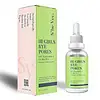What's inside
What's inside
 Key Ingredients
Key Ingredients

 Benefits
Benefits

 Concerns
Concerns

No concerns
 Ingredients Side-by-side
Ingredients Side-by-side

Water
Skin ConditioningOryza Sativa Bran Water
MaskingNiacinamide
SmoothingSaccharomyces/Rice Ferment Filtrate Extract
AntioxidantTranexamic Acid
AstringentPropylene Glycol
HumectantAlpha-Arbutin
AntioxidantAloe Barbadensis Leaf Juice
Skin ConditioningVaccinium Myrtillus Fruit Extract
Skin ConditioningSodium Hyaluronate
HumectantGlycyrrhiza Glabra Root Extract
BleachingPanthenol
Skin ConditioningInulin
Skin ConditioningFructose
HumectantHydroxyethylcellulose
Emulsion StabilisingTranexamoyl Dipeptide-23
BleachingEthylhexylglycerin
Skin ConditioningCaprylyl Glycol
Emollient1,2-Hexanediol
Skin ConditioningPentylene Glycol
Skin ConditioningWater, Oryza Sativa Bran Water, Niacinamide, Saccharomyces/Rice Ferment Filtrate Extract, Tranexamic Acid, Propylene Glycol, Alpha-Arbutin, Aloe Barbadensis Leaf Juice, Vaccinium Myrtillus Fruit Extract, Sodium Hyaluronate, Glycyrrhiza Glabra Root Extract, Panthenol, Inulin, Fructose, Hydroxyethylcellulose, Tranexamoyl Dipeptide-23, Ethylhexylglycerin, Caprylyl Glycol, 1,2-Hexanediol, Pentylene Glycol
Water
Skin ConditioningNiacinamide
SmoothingPropanediol
SolventAlpha-Arbutin
AntioxidantGlycerin
HumectantZinc PCA
HumectantPhenoxyethanol
PreservativeSalix Alba Bark Extract
AstringentPolysorbate 20
EmulsifyingAloe Barbadensis Leaf Extract
EmollientHydroxyethylcellulose
Emulsion StabilisingPotassium Sorbate
PreservativePropolis Extract
Skin ConditioningHypericum Perforatum Extract
AntimicrobialCalendula Officinalis Flower Extract
MaskingAllantoin
Skin ConditioningSalvia Officinalis Leaf Extract
CleansingSodium Benzoate
MaskingWater, Niacinamide, Propanediol, Alpha-Arbutin, Glycerin, Zinc PCA, Phenoxyethanol, Salix Alba Bark Extract, Polysorbate 20, Aloe Barbadensis Leaf Extract, Hydroxyethylcellulose, Potassium Sorbate, Propolis Extract, Hypericum Perforatum Extract, Calendula Officinalis Flower Extract, Allantoin, Salvia Officinalis Leaf Extract, Sodium Benzoate
Ingredients Explained
These ingredients are found in both products.
Ingredients higher up in an ingredient list are typically present in a larger amount.
Alpha-Arbutin is made from hydroquinone and glucose. It may also be derived from the fermentation of soybeans.
This ingredient an antioxidant, meaning it helps protect your skin cells against damage.
Studies show this ingredient helps improve hyperpigmentation and fade discoloration.
Alpha-Arbutin may be used with other ingredients that help with hyperpigmentation. These ingredients include retinol, Vitamin C, niacinamide, and tranexamic acid.
Learn more about Alpha-ArbutinHydroxyethylcellulose is used to improve the texture of products. It is created from a chemical reaction involving ethylene oxide and alkali-cellulose. Cellulose is a sugar found in plant cell walls and help give plants structure.
This ingredient helps stabilize products by preventing ingredients from separating. It can also help thicken the texture of a product.
This ingredient can also be found in pill medicines to help our bodies digest other ingredients.
Learn more about HydroxyethylcelluloseNiacinamide is a multitasking form of vitamin B3 that strengthens the skin barrier, reduces pores and dark spots, regulates oil, and improves signs of aging.
And the best part? It's gentle and well-tolerated by most skin types, including sensitive and reactive skin.
You might have heard of "niacin flush", or the reddening of skin that causes itchiness. Niacinamide has not been found to cause this.
In very rare cases, some individuals may not be able to tolerate niacinamide at all or experience an allergic reaction to it.
If you are experiencing flaking, irritation, and dryness with this ingredient, be sure to double check all your products as this ingredient can be found in all categories of skincare.
When incorporating niacinamide into your routine, look out for concentration amounts. Typically, 5% niacinamide provides benefits such as fading dark spots. However, if you have sensitive skin, it is better to begin with a smaller concentration.
When you apply niacinamide to your skin, your body converts it into nicotinamide adenine dinucleotide (NAD). NAD is an essential coenzyme that is already found in your cells as "fuel" and powers countless biological processes.
In your skin, NAD helps repair cell damage, produce new healthy cells, support collagen production, strengthen the skin barrier, and fight environmental stressors (like UV and pollution).
Our natural NAD levels start to decline with age, leading to slower skin repair, visible aging, and a weaker skin barrier. By providing your skin niacinamide, you're recharging your skin's NAD levels. This leads to stronger, healthier, and younger looking skin.
Another name for vitamin B3 is nicotinamide. This vitamin is water-soluble and our bodies don't store it. We obtain Vitamin B3 from either food or skincare. Meat, fish, wheat, yeast, and leafy greens contain vitamin B3.
The type of niacinamide used in skincare is synthetically created.
Learn more about NiacinamideWater. It's the most common cosmetic ingredient of all. You'll usually see it at the top of ingredient lists, meaning that it makes up the largest part of the product.
So why is it so popular? Water most often acts as a solvent - this means that it helps dissolve other ingredients into the formulation.
You'll also recognize water as that liquid we all need to stay alive. If you see this, drink a glass of water. Stay hydrated!
Learn more about Water